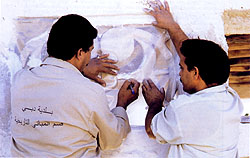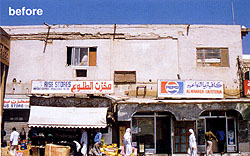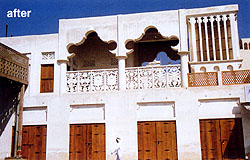 "When I was a child I used to walk around the old souq with my father. He would tell me stories and show me where he had played as a boy. He had grown up in a different era and experienced traditional culture first hand, but I knew nothing about the history of my country except what he told me. It was an important part of my education about my country's past and culture to listen to his stories and visit the places he had grown up in.
"When I was a child I used to walk around the old souq with my father. He would tell me stories and show me where he had played as a boy. He had grown up in a different era and experienced traditional culture first hand, but I knew nothing about the history of my country except what he told me. It was an important part of my education about my country's past and culture to listen to his stories and visit the places he had grown up in.
"During the last two decades, as Dubai became more crowded, I started to feel that preserving our historic buildings was very important. I was overcome by a feeling that is hard to describe," says architect Salim Al Nuaimi.
"I was concerned that when I have children of my own there would be nothing left of the past to show them. By preserving a building I feel you can capture a moment in history, a glimpse of life in the past."
Dubai has been at the forefront of the movement to preserve the Emirate's heritage since the early 1980s and in the last decade Dubai Municipality has funded a major, long term historic building restoration plan. This plan is coordinated by the Archaeological Buildings Restoration Unit.
Since graduating from Al Ain University eighteen months ago Salim Al Nuaimi has worked as an architect and engineer with the Historical Building Section, a sub-section of the Archaeological Buildings Restoration Unit.
The section's activities began with the restoration of Shaikh Saeed Al Maktoum House, and since then it has undertaken the restoration of many more buildings, including Al Fahidi Fort, Al Ahmadiya School, Al Wakeel House, Al Ghuraifa Majlis and the Historical Hatta Village.
From 1991 to 1995 the section developed 50 varied restoration projects and now has a team of 260 workers including carpenters, ornamental specialists, engineers and architects such as Al Nuaimi.
As part of the long term renovation plans Dubai Municipality designated four areas in the centre of Dubai as Historical Zones where conserving traditional patterns of architecture, particularly in respect of height and finishing materials is a priority.
A stroll round these conservation areas in Al Bastikiya, Al Ras, the Creek elevations and the Grand Souq can transport you back to a different era and show a more traditional side to Dubai than the modern high rises that line Shaikh Zayed Road.
"When a building stands by itself it is simply a monument to the past. When whole areas can be restored a whole way of life is preserved," said Al Nuaimi, adding that plans are also underway to transform the Al Shindagah area into a Historic Zone.
The Historical Buildings Section is divided into three main divisions: the Studies and Research section, responsible for researching the history of buildings and drawing up detailed restoration plans, the Restoration section, which carries out the renovations and the Furnishings and Interiors section, which adds the finishing touches to restored buildings.
 The Studies and Research Division is divided into two further sub sections and Al Nuaimi is one of two local architects working in the first of these sections, which is responsible for all the documentation work concerning the restored buildings.
The Studies and Research Division is divided into two further sub sections and Al Nuaimi is one of two local architects working in the first of these sections, which is responsible for all the documentation work concerning the restored buildings.
"We research the history of a building and study the site, deciding whether it is historically valuable. We look at the mortar used, structural stability and complete a preliminary study. We also keep a heritage archive documenting the social and architectural history of Dubai, which includes a large photographic library containing more than 30,000 photographs."
 The second sub section of the Studies and Research Division is the Design Section, which is assigned to a building which has been approved as meriting restoration. They carry out an architectural and engineering survey of the site, note all the dimensions of the structure and the materials used in the building as it exists today. They assess the historical study and develop a design for the restoration of the property.
The second sub section of the Studies and Research Division is the Design Section, which is assigned to a building which has been approved as meriting restoration. They carry out an architectural and engineering survey of the site, note all the dimensions of the structure and the materials used in the building as it exists today. They assess the historical study and develop a design for the restoration of the property.
To help them in their renovation plans the historians and architects have access to documents and photographs in the British Archives documenting some of the history of these older buildings. They also talk to the older generation of Dubai to find out more about the architecture of some of these sites to enable the rebuilding to be performed in line with the styles of the past.
After these designs are drawn up they are given to the Restoration Unit to carry out the building and restoration work.
Al Nuaimi said that the original building materials, such as coral stone and a unique type of gypsum made in the Emirates can no longer be found locally so similar materials are sourced from Africa, India and Iran. "Not all the historic buildings are renovated using old-style materials. Some dating from the 1950s are reconstructed using modern materials, such as cement. These renovations are considered to be of historical value because they incorporate traditional architectural features and engineering methods," he said.
The final stage of the restoration process is carried out by the interior designers in the Furnishings Unit. Some of the original ornamental features of the buildings are donated by private individuals. Otherwise, the designers manufacture the traditional furnishings and fittings themselves.
Most of the major restorations are expected to be finished by 2018 though there will be ongoing maintenance of properties after this date. The studies and historical research being carried out by the section is scheduled to be completed by 2015 and their findings will eventually be published as a reference text for students and scholars wishing to study the UAE's unique architectural heritage.
An important element of the department's work is to raise its profile. The department gives lectures and has published a brochure in the journal Arts and the Islamic World on The Traditional Architecture of Dubai.
The message seems to be hitting home with the younger generation in Dubai. "Recently one of my friends asked me to design a villa for him incorporating traditional techniques and capturing the beauty of traditional architecture," said Al Nuaimi, "I was very happy to agree."
Architectural Landmarks
Dubai is home to a wealth of historic buildings with the oldest, Al Fahidi Fort, dating back to 1799. There are also a number of watchtowers and other buildings dating back to 1830 to 1860.
Many of these sites have now been restored and are a lasting tribute to Dubai's past as an important trading port and to the culture and traditions of it's people.
A tour of these sites is an essential part of any visit to the Emirate and many are now main attractions for the country's growing number of tourists:
Al Fahidi Fort
This is Dubai's oldest surviving structure with the fort's cylindrical 12m tower in the south west corner dating from 1799. It was used as the Ruler's residence until 1890 when the late Shaikh Maktoum bin Hasher Al Maktoum moved to the Shindagah area. It was later used as an armoury and in 1970 it was converted into Dubai's National Museum.
"One of the watchtowers is thought to have been part of the original city wall or boundary of Dubai which no longer exists and is not photographed or documented," says Al Nuaimi with regret.
Built for sea defences, the fort comprises a large courtyard surrounded on three sides by long narrow halls. The fort was originally renovated in 1971 but more work was carried out in the early 1990s when an underground extension was added to house the museum. The project took more than three years to complete.
Shaikh Saeed Al Maktoum House
Built in 1896 this imposing building with its four elegant wind-towers was residence to the former Ruler Shaikh Saeed Al Maktoum until his death in 1958. But after careful restoration the house, which is strategically located at the mouth of Dubai Creek, has been opened to the public as a museum.
Shaikh Saeed House was built in a traditional style around a large courtyard and was added to and finally completed over a number of years, as was usual at this time. Restoration work commenced on the property in 1984 and was completed two years later, using traditional building materials and techniques, and where necessary strengthening the structure with modern materials.
The restoration is remarkable for its carved teak wood doors, wooden lattice screens and the ballustrades of railings. It also features the traditional windtowers, an essential part of any older building in the Gulf, which helped residents survive the heat of the summer. The square masonry towers or barjeels are open on all sides and rise above the roof tops, catching the wind and funnelling it into the rooms below.
Majlis Al Ghuraifa
Built around 1955 the majlis was a summer retreat for the late Shaikh Rashid bin Saeed Al Maktoum the Ruler of Dubai and is situated in a 3,300sqm park in Umm Suqeim. Measuring 100 square metres in area, the simple two storey building is constructed of traditional materials such as coral stone and gypsum.
The ground floor consists of an open leewan (terrace) and also a small storeroom, while on the second floor the majlis is decorated in traditional style with carpets, cushions and Arabic coffee pots.
Landscaping around the majlis includes a boundary wall with gypsum decorative panels and Dubai Municipality have planned a traditional Arabic garden complete with falaj (a traditional system of irrigation channels).